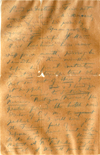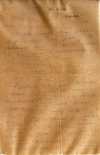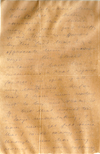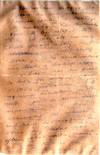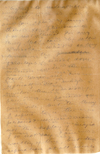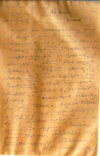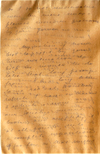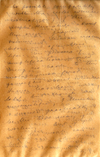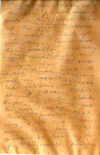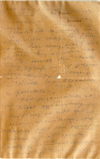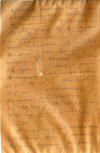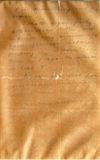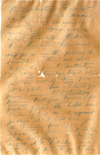|
|
| Line 1: |
Line 1: |
| [[File:Hermes.png|right|200px|thumb|Medieval Drawing of Hermes Trismegistus]] | | {{Infobox MLbox |
| '''Hermeticism''' is a philosophical system based on writings attributed to [[Hermes Trismegistus]], a legendary combination of the Greek god Hermes, his Roman counterpart Mercury, and the Egyptian god of wisdom, Thoth. | | | header1 = People involved | |
| | | writtenby = [[Morya]], [[A. P. Sinnett]] |
| | | receivedby = [[A. P. Sinnett]], [[Morya]], [[H. P. Blavatsky]] |
| | | sentvia = unknown{{pad|10em}} |
| | | header2 = Dates |
| | | writtendate = October 1881 |
| | | receiveddate = unknown |
| | | otherdate = unknown |
| | | header3 = Places |
| | | sentfrom = Simla or Allahabad |
| | | receivedat = unknown |
| | | vialocation = unknown |
| | }} |
| | This letter has not been published previously. [[A. P. Sinnett]] wrote to [[Mahatma]] [[Morya]], who added a note and gave the original to [[H. P. Blavatsky]] to preserve. This letter is a request for information from M., during the period of time when his usual correspondent, [[Mahatma]] [[koot Hoomi]] was in retreat. See also '''[[Mahatma Letter No. 29]]''', '''[[Mahatma_Letter_of_Sinnett_to/from_M_-_1881-10-17|his letter dated October 17]]''', and the '''[[Cosmological Notes]]'''. |
|
| |
|
| == Origins of Hermeticism == | | == Note to H. P. Blavatsky or A. P. Sinnett from M. == |
| '''THIS SECTION UNDER CONSTRUCTION'''<br>
| |
| '''THIS SECTION UNDER CONSTRUCTION'''<br>
| |
|
| |
|
| Hermeticism professes a lineage from a '''''prisca theologia,''''' an ancient theology underlying all religions. Historians believe that the origins of the Hermetic school of thought go back to Hellenistic Egypt, around 400-100 BCE.
| | {{Col-begin|width=98%}} |
| | {{Col-break|width=55%}} |
| | '''Note written in blue-green ink across the top of page 12:'''<br> |
| | Read and destroy. Fear not everything lovely M ... ... ... I am in his ... by your deed Yes – your deed is not the meri... K.H. – ... Kashmir he is now stiff for a month, passing his Samadhi of three months before his final initiation and - it is ...t... trial which not one out of three pass it happily. ... if I send you Hume’s answer to Saturday Review. [[Clive Rattigan|Ratigan]] [[The Pioneer (periodical)|Pioneer’s]] pro ... forced the bottle[-]nosed Editor of C & M [Gazette] to publish it. I will send you the Tribune full of in and out defense [[A. O. Hume|Mr Hume]] sent editors to the best papers to Hindu [Hindoo] Patriot, A B Patrika Englishman etc. if they all printed them |
|
| |
|
| == Foundational writings == | | {{Col-break|width=3%}} |
| | {{Col-break|width=15%}} |
|
| |
|
| The Hermetic teachings are collectively known as '''Hermetica'''. [[Hermes Trismegistus]], or his followers, are credited with writing forty-two books according to Clement of Alexander<ref>[https://platopagan.tripod.com/hermetic_books.htm The 42 Hermetic Books Cited by Clement of Alexandria (ca. 150-215 A.D.)] Quoted from a Clement of Alexandria work entitled ''Stromata'' (Miscellanies), Book VI, Chapter 4.</ref>. Clement described the sacred ceremonial of the ancient Egyptians as requiring use of hermetic books containing "the hymns of the gods and rules of conduct for the kings."<ref>[https://www.biblicalcyclopedia.com/H/hermes-trismegistus-or-mercurius.html Hermes Trismegistus, or Mercurius].</ref> Four books are related to astrology and others are alchemical. Another group presents philosophical concepts in the form of dialogues, in the style of [[Plato]]. Among the best-known works are ''Corpus Hermeticum'' and ''The Emerald Tablet''. The original works were written in Greek and Arabic. In 1948, an additional work was discovered in the Nag Hammadi Collection: ''The Discourse on the Eighth and Ninth,'' which seems to be in initiation rite. It is now considered to be the eighteenth treatise of the ''Corpus Hermeticum''. A Greek version of parts of the 6th treatise in the ''Corpus Hermeticum'' was also found at Nag Hammadi.
| | [http://www.theosophy.wiki/mywiki/images/ML/UnpubM10_12_Mnote.jpg http://www.theosophy.wiki/mywiki/images/ML/UnpubM10_12_Mnote_thm.jpg] |
|
| |
|
| The writings that are now available to us were almost certainly altered or sanitized by Christian interpreters, and represent only a fraction of the original occult teachings. Egyptologist James Bonwick wrote:
| | {{Col-break|width=30%}} |
| <blockquote>
| |
| They are more or less touched up by the Platonic philosophers among the early Christians (such as Origen and Clemens Alexandrinus) who sought to substantiate their Christian arguments by appeals to these heathen and revered writings, though they could not resist the temptation of making them say a little too much."<ref>James Bonwick, ''Egyptian Belief and Modern Thought'' (London: Kegan Paul & Co., 1878), 390.</ref>
| |
| </blockquote>
| |
|
| |
|
| '''''The Divine Pymander''''', often cited as a separate work, is actually the first treatise within the ''Corpus Hermeticum''. Pymander or Poimandres means "the divine Thought" or "man-shepherd." The personified [[Nous]] appears to [[Hermes Trismegistus]] to give him instruction in esoteric concepts. | | '''NOTES:''' |
|
| | * '''Ratigan''' refers to [[Clive Rattigan]], new owner of ''The Pioneer'', Sinnett's employer. |
| === ''Corpus Hermeticum'' ===
| |
|
| |
|
| The ''Corpus Hermeticum'' became available as a manuscript in the fifteenth century, although the work was much older. Thought to have been written anywhere from 100 BCE to 1462 CE, the writings were lost or underground until 1452, when the document was rediscovered in Macedonia. Marsilio Ficino (1433–1499) began translating the ''Corpus'' from Greek into Latin. He completed translation of the first fourteen treatises, and Lodovico Lazzarelli (1447–1500) translated the remaining three.<ref>Brian P. Copenhaver,''Hermetica: The Greek Corpus Hermeticum and the Latin Asclepius in a New English Translation, with Notes and Introduction''. (Cambridge: Cambridge University Press, 1992), xlvii–xlviii.</ref><ref>Wouter Hanegraaff, "Lazzarelli, Lodovico". In
| | {{Col-end}} |
| ''Dictionary of Gnosis and Western Esotericism'' (Leiden: Brill, 2006), 680.</ref>
| |
|
| |
|
| [[File:Hermetic Art 1.jpg|right|200px|thumb|Hermetic illustration of astrological medicine, Iatromathematica]]
| | == Page 1 of Sinnett letter transcription, image, and notes == |
| The treatises within the ''Corpus'' include:
| |
|
| |
|
| # Discourse of Poimandres to [[Hermes Trismegistus]] – also known as ''The Divine Pymander''
| | {{Col-begin|width=98%}} |
| # Hermes to Asclepius
| | {{Col-break|width=55%}} |
| # A sacred discourse of Hermes
| | To |
| # A discourse of Hermes to Tat: The mixing bowl or the monad
| | M ... |
| # A discourse of Hermes to Tat, his son: That god is invisible and entirely visible
| |
| # Hermes to Asclepius: That the good is in god alone and nowhere else
| |
| # That the greatest evil in mankind is ignorance concerning god
| |
| # Hermes to Tat: That none of the things that are is destroyed, and they are mistaken who say that changes are deaths and destructions
| |
| # Hermes to Asclepius: On understanding and sensation: [That the beautiful and good are in god alone and nowhere else]
| |
| # Hermes to Tat: The key
| |
| # Mind (''[[Nous]]'') to Hermes
| |
| # Hermes to Tat: On the mind shared in common
| |
| # Hermes to Tat, a secret dialogue on the mountain: On being born again, and on the promise to be silent
| |
| # Hermes to Asclepius: health of mind
| |
| # Asclepius to King Ammon: Definitions on god, matter, vice, fate, the sun, intellectual essence, divine essence, mankind, the arrangement of the plenitude, the seven stars, and mankind according to the image
| |
| # Asclepius to King Ammon
| |
| # Tat to a king: On the soul hindered by the body's affections
| |
|
| |
|
| === ''The Emerald Tablet'' ===
| | I am more than pleased to find you are getting to tolerate me to some extent. In that case it will not ... you to receive letters from me and you can ... ............. |
|
| |
|
| ''The Emerald Tablet'' or ''Smaragdine Tablet'', was written in a manner that is intentionally enigmatic to obscure the meaning to all but those trained in [[alchemy]]. The ''Tablet'' presents some of the most basic concepts in occultism, including '''"As above, so below"''':
| | I should like you to read a letter I wrote to my boss and friend, your brother (from a very full heart) on my way up here, at Soleni! It would probably show you, even more than my mere words for you can as we say read between the lines – |
|
| |
|
| <blockquote>
| | {{Col-break|width=3%}} |
| It is true, no lie, certain, to be depended upon: What is below is like that which is above, and what is above is similar to that which is below to accomplish the wonders of one thing. As all things were produced by the mediation of one being, so all things were produced from this one by adaptation. Its father is the sun, its mother is the moon. It is the cause of all perfection throughout the whole earth. Its power is perfect if it is changed into earth. Separate the earth from the fire, the subtle from the gross, acting prudently and with judgment. Ascend with the greatest sagacity from the earth to heaven, and then descend again to earth, and unite together the power of things inferior and superior; thus you will possess the light of the whole world, and all obscurity will fly away from you. This thing has more fortitude than fortitude itself, because it will overcome every subtle thing and penetrate every solid thing. By it the world was formed.
| |
| </blockquote>
| |
|
| |
|
| == Concepts of Hermeticism == | | {{Col-break|width=15%}} |
|
| |
|
| As Christopher Bamford has written, " Hermeticism is the sacred science of realizing and enhancing the subtle states of both the human being and the universe, which correspond to each other."<ref>Christopher Bamford, "Green Hermeticism: ''Quest'' 97 no.2 (Spring, 2009), 54-59, 63.</ref>
| | [http://www.theosophy.wiki/mywiki/images/ML/UnpubM10_1.jpg http://www.theosophy.wiki/mywiki/images/ML/UnpubM10_1_thm.jpg] |
|
| |
|
| Fundamental to understanding Hermeticism is a knowledge or '''gnosis''' that cannot be taught. Gnosis reveals in an experiential way the total unity of everything in the universe. Hermeticism is not a religion of faith or belief; it is about knowing that requires no trust in something unseen or unproven. Frances Yates describes Hermeticism as a religion "without temples or liturgy, followed in the mind alone."<ref>Frances A. Yates, ''Giordano Bruno and the Hermetic Tradition'' (London: Routledge & Kegan Paul, 1971), 13.</ref> The ways of opening oneself to gnosis can be taught to an aspirant but the experience itself is a direct, intuitive, very personal grasp of divine reality and the unity of everything. Achieving this gnosis or cosmic consciousness is necessary to the hermeticist because this is how he becomes fully human.
| | {{Col-break|width=30%}} |
|
| |
|
| Belief in '''[[reincarnation]]''' is another feature of Hermeticism. "O son, how many bodies we have to pass through, how many bands of demons, through how many series of repetitions and cycles of the stars, before we hasten to the One Alone?”<ref>Clement Salaman, Dorine Van Oyen, William D. Wharton, and Jean-Pierre Mahé. ''The Way of Hermes: New Translations of The Corpus Hermeticum and The Definitions of Hermes Trismegistus to Asclepius'' (Rochester: Inner Traditions, 2000), 33.</ref>
| | '''NOTES:''' |
| | * '''Boss and friend, your brother''' refers to [[Mahatma]] [[Koot Hoomi]]. |
|
| |
|
| Another aspect of Hermeticism is the belief that '''Man is the equal of God'''. "If you do not make yourself the equal of God you cannot understand him. Like is understood by Like."<ref>Gary Lachman, ''The Quest for Hermes Trismegistus: From Ancient Egypt to the Modern World'' (2011), 35.</ref>
| | {{Col-end}} |
|
| |
|
| <blockquote>
| | == Page 2 == |
| Command your soul to go anywhere, and it will be there quicker than your command. Bid it to go to the ocean and it will need no wings... Suppose nothing to be impossible to you. Conceive yourself to be in all places at the same time; in earth, in the sea, in heaven; that you are not born yet, that you are within the womb, that you are young, old, dead. Conceive all things at once; times, places, actions, qualities and quantities; then you can understand God.<ref>Gary Lachman, ''The Quest for Hermes Trismegistus: From Ancient Egypt to the Modern World''. (2011), 35.</ref>
| |
| </blockquote>
| |
|
| |
|
| Some schools of hermetic thought believe "God only knows what you know," suggesting that man’s journey on earth is a learning experience for the creator, as well as the individual.
| | {{Col-begin|width=98%}} |
| | {{Col-break|width=55%}} |
|
| |
|
| [[File:The Magician 1.png|right|140px|thumb|The Magician in Tarot]]
| |
|
| |
|
| This theory of God and man fits perfectly into the doctrine of "as above, so below," or the '''[[Law of Correspondences]]'''. The ''Smaragdine Tablet'' or ''Emerald tablet'' of Hermes, opens with the words:
| | {{Col-break|width=3%}} |
| <blockquote>
| |
| What is below is like that which is above, and what is above is similar to that which is below.
| |
| </blockquote>
| |
|
| |
|
| Actions on one level of reality – physical, emotional or mental – happens on all levels. This doctrine echoes through most occult disciplines. In the Tarot, the first card of the major arcana is the Magician depicted with one arm pointing up and the other pointing down signifying “as above, so below.” On the table before him are the representations of the four basic elements – earth (pentacles), wind (swords), fire (wands) and water (cups) – all controlled by the same doctrine.
| | {{Col-break|width=15%}} |
|
| |
|
| The Hermetica put forth three types of wisdom – [[Alchemy]], [[Astrology]], and [[Theurgy]]. Alchemy is the operation of the sun or the striving for perfection. Astrology is the operation of the stars, their influences upon the human being, and the work required to rise above the influences of the heavens. Theurgy is the operation of the gods or magic.
| | [http://www.theosophy.wiki/mywiki/images/ML/UnpubM10_2.jpg http://www.theosophy.wiki/mywiki/images/ML/UnpubM10_2_thm.jpg] |
|
| |
|
| Seven principles are presented in the Hermetica:
| | {{Col-break|width=30%}} |
|
| |
|
| 1. '''The Principle of Mentalism''': The All is mind; The Universe is Mental.<br>
| | '''NOTES:''' |
| 2. '''The Principle of Correspondence''': As above, so below; as below, so above. As within, so without; as without, so within.<br>
| | * |
| 3. '''The Principle of Vibration''': Nothing rests; Everything moves; Everything vibrates.<br>
| |
| 4. '''The Principle of Polarity''': Everything is dual; Everything has poles; Like and unlike are the same; Opposites are identical in nature, but different in degree; All truths, are but half-truths; All paradoxes may be reconciled.<br>
| |
| 5. '''The Principle of Rhythm''': Everything flows, out and in; Everything has its tides; All things rise and fall; The pendulum swing manifests in everything. Rhythm compensates.<br>
| |
| 6. '''The Principle of Cause & Effect''': Every cause has its effect; Every effect has its cause; Everything happens according to law.<br>
| |
| 7. '''The Principle of Gender''': Gender is in everything; Everything has its masculine and feminine principles; Gender manifests on all planes.
| |
|
| |
|
| == Influence of Hermeticism ==
| | {{Col-end}} |
|
| |
|
| Hermeticism has influenced some of the greatest thinkers of the ancient and modern worlds.
| | == Page 3 == |
|
| |
|
| === In Renaissance thought === | | {{Col-begin|width=98%}} |
| | {{Col-break|width=55%}} |
|
| |
|
| '''Marsilio Ficino''', Cosimo De Medici’s scribe who translated the newly unearthed Hermetic documents in 1463, was profoundly affected by the information he acquired from the writings. Ficino became a Roman Catholic priest and a high ranking official at the Cathedral of Florence. He hoped to merge Hermetic concepts into the Catholic religion but the Inquisition was still operational so he had to be extremely careful.
| |
|
| |
|
| '''[[Pico della Mirandola|Giovanni Pico della Mirandola]]''', a student of Ficino, was a Renaissance philosopher famous for his ''Oration on the Dignity of Man''. Pico studied the mystical writings ascribed to Hermes Trismegistus, Zoroaster and Moses, Orpheus and Pythagoras, Christian theology, Islamic philosophy, and the Hebrew Qabalah.<ref>Katinka Hesselink, Katinka.http://www.katinkahesselink.net/his/PicoDellaMirandola.htm "Pico della Mirandola"] Accessed on 3/25/2022.</ref><ref>[https://www.encyclopedia.com/people/philosophy-and-religion/philosophy-biographies/giovanni-pico-della-mirandola "Pico della Mirandolla, Giovanni"]. Accessed on 3/25/2022.</ref> Along with Ficino, he followed the doctrine of '''''Prisca Theologia''''', holding that one true theology – the real basis for all religions – was given to mankind in antiquity.
| | {{Col-break|width=3%}} |
|
| |
|
| '''[[Giordano Bruno]]''' (1548-1600) was also deeply influenced by hermeticism, along with [[astrology]] and [[Rosicrucianism]]. He developed a cosmology in which he viewed the universe as infinite and eternal; with a heliocentric model of the solar system; and the divinity, unity, and interdependence of all things.
| | {{Col-break|width=15%}} |
|
| |
|
| === In Theosophy ===
| | [http://www.theosophy.wiki/mywiki/images/ML/UnpubM10_3.jpg http://www.theosophy.wiki/mywiki/images/ML/UnpubM10_3_thm.jpg] |
| '''THIS SECTION UNDER CONSTRUCTION'''<br>
| |
| '''THIS SECTION UNDER CONSTRUCTION'''<br>
| |
|
| |
|
| The seven principles of Hermeticism are essential elements of [[Theosophy]].
| | {{Col-break|width=30%}} |
|
| |
|
| According to Theosophy, “Thoth-Hermes was one of the King-Instructors, the '[[Sons of the Fire]],' who began in [[Lemuria]] in the Third Race to instruct infant humanity in the arts and sciences. The Egyptians always regarded Thoth-Hermes as a symbol of the Third Race. But in whichever of his characters Hermes appears, he is always credited as the first to teach the science of magic to the Egyptians.”<ref>Author Unknown, "Great Theosophists – Alchemy and the Alchemists" ''Theosophy'' 25 no. 11 (September, 1937), 490-496.</ref>
| | '''NOTES:''' |
| | * |
|
| |
|
| === In modern thought ===
| | {{Col-end}} |
|
| |
|
| '''Green Hermeticism''' is a movement arising from a 2003 conference on "Sacred Theory of Earth" in New Paltz, New York. Participants included Christopher Bamford, Peter Lamborn Wilson, Kevin Townley and Pir Zia Inayat Khan, and various other
| | == Page 4 == |
| "hermeticists, poets, Christians, Buddhists, neo-pagans, Sufis, and assorted heretics."<ref>Christopher Bamford, "Green Hermeticism: ''Quest'' 97 no.2 (Spring, 2009), 54-59, 63.</ref> They explored the application of alchemical principles to environmental science.
| |
| <blockquote>
| |
| Green Hermeticism seeks to found a new, truly spiritual ecology: a new Hermetic culture, in which the earth will once again become the temple of the cosmos, with every human being a healing priest or priestess. In practice, this means a renewed understanding of the earth as a cosmic being that awaits human collaboration to awaken to its true destiny.<ref>Bamford, 54-59, 63.</ref>
| |
| </blockquote>
| |
|
| |
|
| In a completely different approach to modern hermeticism, Joseph Rodrigues, Colton Swabb, and others have focused on the application of Hermetic concepts to achieve '''prosperity''. There are many books and websites proposing this approach as a form of thought power.
| | {{Col-begin|width=98%}} |
| | {{Col-break|width=55%}} |
|
| |
|
| === In science and medicine ===
| |
| [[File:TheCaduceus.png|right|150px|thumb|The Caduceus]]
| |
| Study of hermeticism led humanity toward modern science and medicine.
| |
|
| |
|
| [[Alchemy]] is the study of how to purify and transmute human beings to realize their divine potential. The early alchemists combined chemical notations with ancient mythologies into a symbolic language to convey their spiritual experiences when words were inadequate. The idea that man should control his destiny rather than be a victim to the influence of the stars led to the concept of influencing or controlling nature. This was of great interest to the developing discipline of science. '''Sir Isaac Newton''', for example, studyied the ''Corpus Hermeticum'' – in secret, due to the powerful Church’s disapproval of alchemy.
| | {{Col-break|width=3%}} |
|
| |
|
| The secrecy surrounding alchemy led to many misunderstandings concerning what alchemy intended to accomplish. Interest in the exoteric view of alchemy converting base metal to gold, took the direction of developing the modern science of chemistry. The efforts of [[Paracelsus]], also misunderstanding the true nature of alchemy, led to the beginning of pharmacology.
| | {{Col-break|width=15%}} |
|
| |
|
| The '''caduceus''' that has become the symbol used for modern medicine comes directly from hermeticism. The serpent was a symbol of wisdom associated with Hermes-Thoth in ancient times. One story of how the caduceus was created tells that when Hermes came upon two snakes locked in mortal combat, he separated them with his staff and acting as mediator brought peace between them by suggesting an alchemical reconciliation. Snakes shed their skins and appear to be reborn, and are connected symbolically to both magic and medicine.
| | [http://www.theosophy.wiki/mywiki/images/ML/UnpubM10_4.jpg http://www.theosophy.wiki/mywiki/images/ML/UnpubM10_4_thm.jpg] |
|
| |
|
| == Additional resources == | | {{Col-break|width=30%}} |
| | |
| | '''NOTES:''' |
| | * |
| | |
| | {{Col-end}} |
| | |
| | == Page 5 == |
| | |
| | {{Col-begin|width=98%}} |
| | {{Col-break|width=55%}} |
| | |
| | |
| | {{Col-break|width=3%}} |
| | |
| | {{Col-break|width=15%}} |
| | |
| | [http://www.theosophy.wiki/mywiki/images/ML/UnpubM10_5.jpg http://www.theosophy.wiki/mywiki/images/ML/UnpubM10_5_thm.jpg] |
| | |
| | {{Col-break|width=30%}} |
| | |
| | '''NOTES:''' |
| | * |
| | |
| | {{Col-end}} |
| | |
| | == Page 6 == |
| | |
| | {{Col-begin|width=98%}} |
| | {{Col-break|width=55%}} |
| | |
| | |
| | {{Col-break|width=3%}} |
| | |
| | {{Col-break|width=15%}} |
| | |
| | [http://www.theosophy.wiki/mywiki/images/ML/UnpubM10_6.jpg http://www.theosophy.wiki/mywiki/images/ML/UnpubM10_6_thm.jpg] |
| | |
| | {{Col-break|width=30%}} |
| | |
| | '''NOTES:''' |
| | * |
| | |
| | {{Col-end}} |
| | |
| | == Page 7 == |
| | |
| | {{Col-begin|width=98%}} |
| | {{Col-break|width=55%}} |
| | |
| | |
| | {{Col-break|width=3%}} |
| | |
| | {{Col-break|width=15%}} |
| | |
| | [http://www.theosophy.wiki/mywiki/images/ML/UnpubM10_7.jpg http://www.theosophy.wiki/mywiki/images/ML/UnpubM10_7_thm.jpg] |
| | |
| | {{Col-break|width=30%}} |
| | |
| | '''NOTES:''' |
| | * |
| | |
| | {{Col-end}} |
| | |
| | == Page 8 == |
| | |
| | {{Col-begin|width=98%}} |
| | {{Col-break|width=55%}} |
| | |
| | |
| | {{Col-break|width=3%}} |
| | |
| | {{Col-break|width=15%}} |
| | |
| | [http://www.theosophy.wiki/mywiki/images/ML/UnpubM10_8.jpg http://www.theosophy.wiki/mywiki/images/ML/UnpubM10_8_thm.jpg] |
| | |
| | {{Col-break|width=30%}} |
| | |
| | '''NOTES:''' |
| | * |
| | |
| | {{Col-end}} |
| | |
| | |
| | == Page 9 == |
| | |
| | {{Col-begin|width=98%}} |
| | {{Col-break|width=55%}} |
| | |
| | |
| | {{Col-break|width=3%}} |
| | |
| | {{Col-break|width=15%}} |
| | |
| | [http://www.theosophy.wiki/mywiki/images/ML/UnpubM10_9.jpg http://www.theosophy.wiki/mywiki/images/ML/UnpubM10_9_thm.jpg] |
| | |
| | {{Col-break|width=30%}} |
| | |
| | '''NOTES:''' |
| | * |
| | |
| | {{Col-end}} |
| | |
| | == Page 10 == |
| | |
| | {{Col-begin|width=98%}} |
| | {{Col-break|width=55%}} |
| | |
| | |
| | {{Col-break|width=3%}} |
| | |
| | {{Col-break|width=15%}} |
| | |
| | [http://www.theosophy.wiki/mywiki/images/ML/UnpubM10_10.jpg http://www.theosophy.wiki/mywiki/images/ML/UnpubM10_10_thm.jpg] |
| | |
| | {{Col-break|width=30%}} |
| | |
| | '''NOTES:''' |
| | * |
| | |
| | {{Col-end}} |
| | |
| | == Page 11 == |
| | |
| | {{Col-begin|width=98%}} |
| | {{Col-break|width=55%}} |
| | |
| | |
| | {{Col-break|width=3%}} |
| | |
| | {{Col-break|width=15%}} |
| | |
| | [http://www.theosophy.wiki/mywiki/images/ML/UnpubM10_11.jpg http://www.theosophy.wiki/mywiki/images/ML/UnpubM10_11_thm.jpg] |
| | |
| | {{Col-break|width=30%}} |
| | |
| | '''NOTES:''' |
| | * |
|
| |
|
| === Hermetic writings ===
| | {{Col-end}} |
|
| |
|
| See also [https://en.wikipedia.org/wiki/Hermetica Hermetica] in Wikipedia for a detailed list.
| | == Page 12 == |
|
| |
|
| * '''''[http://www.gnosis.org/library/hermet.htm#CH The Corpus Hermeticum]''''' at the Gnostic Society Library.
| | {{Col-begin|width=98%}} |
| * '''''[https://www.sacred-texts.com/eso/pym/index.htm The Divine Pymander of Hermes Mercurius Trismegistus]'''''. Translated from the Arabic by John Everard. 1650.
| | {{Col-break|width=55%}} |
| * '''''[http://iapsop.com/ssoc/1884__everard_jennings___divine_pymander.pdf The Divine Pymander of Hermes Mercurius Trismegistus]'''''. Translated from the Arabic by John Everard. 1650. London: George Redway, 1884.
| |
| * '''''[https://www.sacred-texts.com/alc/emerald.htm The Emerald Tablet]''''' at Sacred-Texts.com. This site provides several translations of the work, with commentaries.
| |
|
| |
|
| === Books about Hermeticism ===
| |
|
| |
|
| * Bamford, Christopher, Peter Lamborn Wilson, Kevin Townley and Pir Zia Inayat Khan. ''Green Hermeticism: Alchemy and Ecology''. Lindisfarne Books, 2007.
| | {{Col-break|width=3%}} |
|
| |
| * Copenhaver, Brian P. ''[https://ia802801.us.archive.org/17/items/hermetica.thegreekcorpushermeticumandthelatinasclepiustranslatedbybriancopenhaver/Hermetica.%20The%20Greek%20Corpus%20Hermeticum%20and%20the%20Latin%20Asclepius%20translated%20by%20Brian%20Copenhaver.pdf Hermetica: The Greek C. H. and the Latin Asclepius in a new English translation with notes and introduction]''. Cambridge: Cambridge University Press, 1992. Highly recommended.
| |
|
| |
|
| * Fowden, Garth. ''The Egyptian Hermes''. Princeton: Princeton University Press, 1986. This author is one of the best modern scholars on Hermetica.
| | {{Col-break|width=15%}} |
|
| |
|
| * Hancock, Graham, and Robert Bauval. ''Talisman: Sacred Cities, Secret Faith''. London: Michael Joseph, 2004.
| | [http://www.theosophy.wiki/mywiki/images/ML/UnpubM10_12.jpg http://www.theosophy.wiki/mywiki/images/ML/UnpubM10_12_thm.jpg] |
|
| |
|
| * Lachman, Gary. ''The Quest for Hermes Trismegistus: From Ancient Egypt to the Modern World''. , 2011.
| | {{Col-break|width=30%}} |
|
| |
|
| * Mead, G. R. S. ''Thrice-greatest Hermes: Studies in Hellenistic Theosophy and Gnosis, Being a Translation of the Extant Sermons and Fragments of the Trismegistic Literature, with Prolegomena, Commentaries, and Notes.'' London: J.M. Watkins, 1964.
| | '''NOTES:''' |
| | * |
|
| |
|
| * Salaman, Clement, and Hermes. ''The Way of Hermes: Translations of the Corpus Hermeticum and the Definitions of Hermes Trismegistus to Asclepius.'' Rochester, VT: Inner Traditions, 2000.
| | {{Col-end}} |
|
| |
|
| * Wilson, Colin. ''From Atlantis to the Sphinx''. New York: Fromm International Pub, 1997.
| | == Context and background == |
| | Master M. was corresponding with Sinnett during the period in late 1881 when [[Koot Hoomi|Master K.H.]] was in retreat. M. responded to many questions from Sinnett and [[A. O. Hume]], resulting in the '''[[Cosmological Notes]]'''. |
|
| |
|
| * Yates, Frances A. ''Giordano Bruno and the Hermetic Tradition.'' Chicago: Univ. of Chicago Press, 1964.
| | == Physical description of letter == |
|
| |
|
| === Articles ===
| | Three sheets of paper were written on both sides and folded to make 12 pages. Letterhead of [[The Pioneer (periodical)|''The Pioneer'']] was used, as can be seen in the imprints on pages 1, 5, and 9. Notations here by M. are in blue-green ink, although he generally used red ink. This letter is in a private collection. |
|
| |
|
| * [https://www.theosociety.org/pasadena/sunrise/55-05-6/me-elo4.htm "The Emerald Tablet"] by Eloise Hart. Originally published in ''Sunrise magazine'', April/May 2006.
| | == Publication history == |
| * [https://www.theosophical.org/publications/quest-magazine/1664-green-hermeticism "Green Hermeticism"] by Christopher Bamford. Orginally published in ''Quest'' 97 no. 2 (Spring, 2009), 54-59, 63.
| |
|
| |
|
| === Websites ===
| | This letter has never been published before. |
|
| |
|
| * [http://www.gnosis.org/library/ The Gnostic Archive].
| | == Commentary about this letter == |
| * [https://blogs.uoregon.edu/rel399f14drreis/hermeticism/ Hermeticism].
| |
| * [https://medium.com/the-mission/the-hermetic-revival-7-ancient-principles-for-self-mastery-9399e523648d The Hermetic Revival: & Ancient Principles for Self Mastery] by Colton Swabb. Feb 26, 2018.</ref>
| |
|
| |
|
| === Video ===
| | The chief significance of this letter is that it is a rare example of Sinnett's side of his correspondence with the Mahatmas. Sinnett sincerely asks M. for assistance in understanding the occult. |
|
| |
|
| * '''''Hermeticism and Gnosticism''''' by Stephan Hoeller
| | == Additional resources == |
| ** Volume 1: [https://www.youtube.com/watch?v=f5Svff9PiH0 Part 1] and [https://www.youtube.com/watch?v=jleRvDBfacc Part 2].
| |
| ** Volume 2: [https://www.youtube.com/watch?v=x2UX9l6c7dI Part 1] and [https://www.youtube.com/watch?v=Ay2gtDHfmH4 Part 2].
| |
| ** Volume 3: [https://www.youtube.com/watch?v=_rrm8Va-NEA Part 1] and [https://www.youtube.com/watch?v=mf_m232kd28 Part 2].
| |
| ** Volume 4: [https://www.youtube.com/watch?v=_Oz-vSoqyVc Part 1] and [https://www.youtube.com/watch?v=M_tBTdqHme4 Part 2].
| |
| * '''''[https://www.youtube.com/watch?v=zoPtrb2eMCQ What is Hermeticism?]''''' in Esoterica YouTube channel. Posted May 28, 2021.
| |
| * '''''[https://www.youtube.com/watch?v=KupaADzq88g Hermeticism and Ancient Astrology]'''''. A discussion about the ancient philosophy of Hermeticism and its relationship to Hellenistic astrology, with Sam Block and Chris Brennan. Feb 16, 2022.
| |
| * '''''[https://www.youtube.com/watch?v=D8TSCGoSsME The Kybalian by The Three Initiates (The Seven Hermetic Principles)]''''' by Joseph Rodrigues. This presenter focuses on using the seven principles and especially thought power to achieve prosperity, in the tradition of Napoleon Hill's ''Think and Grow Rich''.
| |
|
| |
|
| == Notes == | | == Notes == |
| <references/> | | <references/> |
|
| |
|
| [[Category:Philosophy]] | | [[Category:ML from Morya]] |
| [[Category:Western Esotericism]] | | [[Category:ML to A. P. Sinnett]] |
| [[Category:Schools of Thought]] | | [[Category:ML with images]] |
| | [[Category:ML previously unpublished]] |
